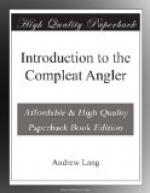As to salmon, Walton scarcely speaks a true word about their habits, except by accident. Concerning pike, he quotes the theory that they are bred by pickerel weed, only as what ‘some think.’ In describing the use of frogs as bait, he makes the famous, or infamous, remark, ’Use him as though you loved him . . . that he may live the longer.’ A bait-fisher may be a good man, as Izaak was, but it is easier for a camel to pass through the eye of a needle. As coarse fish are usually caught only with bait, I shall not follow Izaak on to this unholy and unfamiliar ground, wherein, none the less, grow flowers of Walton’s fancy, and the songs of the old poets are heard. The Practical Angler, indeed, is a book to be marked with flowers, marsh marigolds and fritillaries, and petals of the yellow iris, for the whole provokes us to content, and whispers that word of the apostle, ‘Study to be quiet.’
FISHING THEN AND NOW
Since Maui, the Maori hero, invented barbs for hooks, angling has been essentially one and the same thing. South Sea islanders spin for fish with a mother-of-pearl lure which is also a hook, and answers to our spoon. We have hooks of stone, and hooks of bone; and a bronze hook, found in Ireland, has the familiar Limerick bend. What Homer meant by making anglers throw ‘the horn of an ox of the stall’ into the sea, we can only guess; perhaps a horn minnow is meant, or a little sheath of horn to protect the line. Dead bait, live bait, and imitations of bait have all been employed, and AElian mentions artificial Mayflies used, with a very short line, by the Illyrians.
But, while the same in essence, angling has been improved by human ingenuity. The Waltonian angler, and still more his English predecessors, dealt much in the home-made. The Treatise of the fifteenth century bids you make your ‘Rodde’ of a fair staff even of a six foot long or more, as ye list, of hazel, willow, or ‘aspe’ (ash?), and ’beke hym in an ovyn when ye bake, and let him cool and dry a four weeks or more.’ The pith is taken out of him with a hot iron, and a yard of white hazel is similarly treated, also a fair shoot of blackthorn or crabtree for a top. The butt is bound with hoops of iron, the top is accommodated with a noose, a hair line is looped in the noose, and the angler is equipped. Splicing is not used, but the joints have holes to receive each other, and with this instrument ’ye may walk, and there is no man shall wit whereabout ye go.’ Recipes are given for colouring and plaiting hair lines, and directions for forging hooks. ’The smallest quarell needles’ are used for the tiniest hooks.




